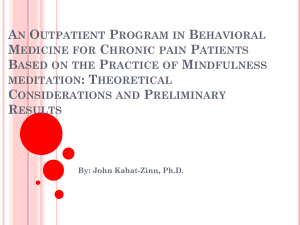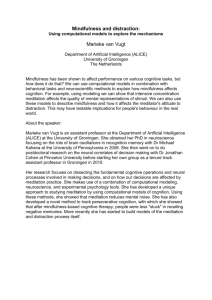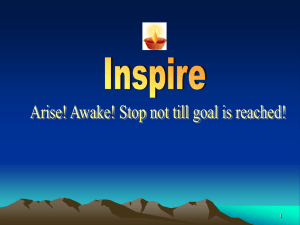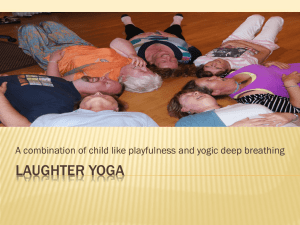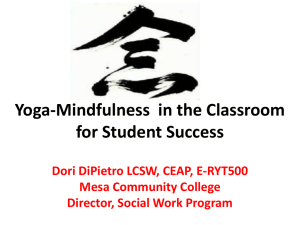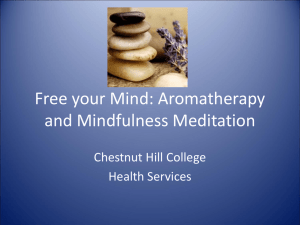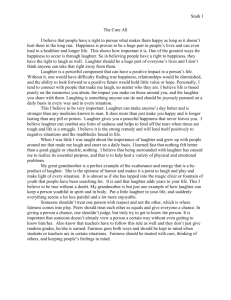docx - Undergraduate Journal of Psychology at Berkeley
advertisement
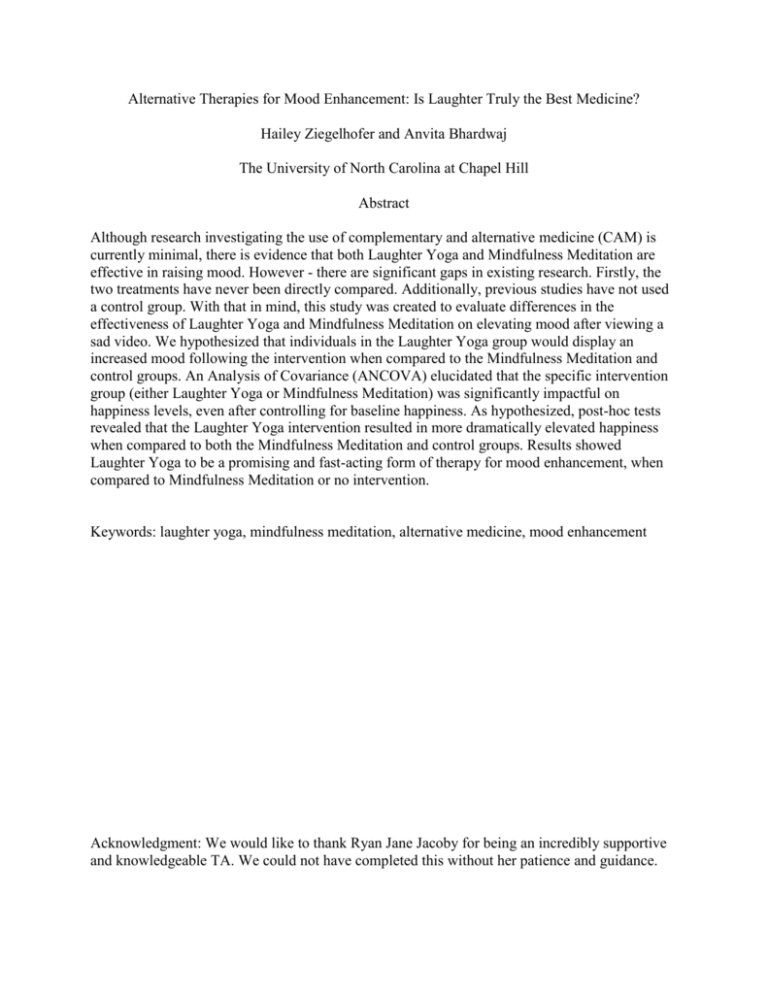
Alternative Therapies for Mood Enhancement: Is Laughter Truly the Best Medicine? Hailey Ziegelhofer and Anvita Bhardwaj The University of North Carolina at Chapel Hill Abstract Although research investigating the use of complementary and alternative medicine (CAM) is currently minimal, there is evidence that both Laughter Yoga and Mindfulness Meditation are effective in raising mood. However - there are significant gaps in existing research. Firstly, the two treatments have never been directly compared. Additionally, previous studies have not used a control group. With that in mind, this study was created to evaluate differences in the effectiveness of Laughter Yoga and Mindfulness Meditation on elevating mood after viewing a sad video. We hypothesized that individuals in the Laughter Yoga group would display an increased mood following the intervention when compared to the Mindfulness Meditation and control groups. An Analysis of Covariance (ANCOVA) elucidated that the specific intervention group (either Laughter Yoga or Mindfulness Meditation) was significantly impactful on happiness levels, even after controlling for baseline happiness. As hypothesized, post-hoc tests revealed that the Laughter Yoga intervention resulted in more dramatically elevated happiness when compared to both the Mindfulness Meditation and control groups. Results showed Laughter Yoga to be a promising and fast-acting form of therapy for mood enhancement, when compared to Mindfulness Meditation or no intervention. Keywords: laughter yoga, mindfulness meditation, alternative medicine, mood enhancement Acknowledgment: We would like to thank Ryan Jane Jacoby for being an incredibly supportive and knowledgeable TA. We could not have completed this without her patience and guidance. Alternative Therapies for Mood Enancement: Is Laughter Truly the Best Medicine? The use of complementary and alternative medicine (CAM) has increased notably in the western world as clinicians and clients alike seek more integrative treatment methods. CAM addresses both mental and physical illnesses, with exercise and mindfulness-based interventions comprising the most widespread approach (MBIs) (Edenfield & Saeed, 2012). Origins of these practices date back centuries to Buddhist and Hindu cultures throughout Southeast Asia. We are interested in the use of these techniques and their effectiveness in enhancing mood, and will specifically focus on Laughter Therapy and Mindfulness Meditation. Alternatives to using cognitive, behavioral, or medical techniques in therapy are of current interest, as they are easier to implement and more economical in regions with low resources. Accordingly, we will first define Laughter Therapy and Mindfulness Meditation and review the current studies available. Next, we will describe the limitations of past studies and introduce our current study on Laughter Yoga and Mindfulness Meditation. Humor and laughter, experiences generally associated with joy and positivity, are shared by all of Earth’s inhabitants. The common statement “laughter is the best medicine” expresses the perceived powers of humor in enhancing mood, yet laughter is not typically implemented in formal treatment (Jacobs, 2009). Current interest in this area has sparked research on the preliminary benefits of laughter and humor on health. Kaspar, Baldwin, Johnson, Edling and Sethi (2012) evaluated the clinical utility of Laughter Yoga in improving psychological and physiological measures in outpatients awaiting organ transplants. These patients already had their heart rate, heart rate variability, and blood pressure closely monitored as part of the transplant process, so researchers were able to easily examine whether Laughter Yoga caused changes in heart rate variability and mood. Each patient participated in a short 20-minute Laughter Yoga exercise which integrated both breathing and stimulated laughter, twice a week, over the course of a month. Participants showed an increased heart rate variability and an improved mood immediately following the month-long Laughter Yoga intervention when compared to control scores during a no-treatment control week (Kaspar, Baldwin, Johnson, Edling, & Sethi, 2012). The study suggests that laughter elevates mood through biological mechanisms. Theories regarding the benefits of laughter and humor posit four mechanisms: physiological changes such as relaxing muscles, positive emotional states, stress moderation, and increased levels of social support (Martin, 2002). More immediate effects such as a positive change in perception are often observed due to the release of endorphins; this further solidifies the beneficial effects of Laughter Yoga on elevating mood. While Laughter Yoga is a fairly new practice, Mindfulness Meditation (known as vipassana) has been used for centuries in Buddhist traditions to release negative emotions and simultaneously generate feelings of happiness. The goal is to center one’s focus on the present situation and attend to thoughts, emotions, and perceptions as they arise without judgment. Mindfulness Meditation requires focused attention and careful examination of the body, which is achieved through practice and learning to avoid distractions. By collectively integrating each mental component into one experience, the goal is to generate awareness of current internal and external experiences with a nonjudgmental stance. Meditation is especially attractive as a treatment for physical and mental health due to its effectiveness, feasibility, and low cost. Specifically, Mindfulness Meditation has been shown to reduce stress, improve overall health, and enhance self-compassion (Giscombé & Gaylord, 2014). Studies have also shown a reduction in anger and pain after meditation therapy, in addition to lower cortisol levels and improved immune functioning. Current proposed mechanisms by which meditation improves health include: attention regulation, body awareness, emotion regulation, and a change in perspective of the self (Hözel et al., 2006). The benefits of Mindfulness Meditation are not only biologically evident, but also impactful on psychological levels, as seen in Ando et al. (2009), where substantial psychological benefits were found in regards to the anxiety, depression, and spiritual well-being of patients undergoing cancer treatments. The subjects participated in two sessions of Mindfulness Meditation, each of which included breathing, yoga, and self-reflection. The results showed that those who participated in Mindfulness Meditation had significantly decreased anxiety and depression scores following the intervention (Ando et al., 2009). However, the study had poor internal validity, as it failed to include a control group. Although the reviewed studies display the efficacy of Laughter Yoga and Mindfulness Meditation as treatment mechanisms for psychological and psychosocial illnesses, no studies have compared the effectiveness of the two interventions. Therefore, our current study intended to examine and compare the effectiveness of Laughter Yoga and Mindfulness Meditation in elevating mood. The addition of a control group in our study offered baseline data to accurately determine whether our interventions acted as the causal force of exhibited mood improvement, or if differences simply resulted from the passage of time. Our incorporation of this group eradicated a significant limitation present in aforementioned studies. We hypothesized that individuals in the two active treatment groups would experience higher post-intervention moods--more happiness and less sadness--following their respected intervention when compared to the control condition, even after controlling for baseline mood. Furthermore, we hypothesized that Laughter Yoga would foster higher post-intervention mood than Mindfulness Meditation. Methods Participants Forty-one undergraduate participants (87.8% female, n =36) were recruited from The University of North Carolina at Chapel Hill from a research methods course as part of a class project. Participants were 20.8 years old on average (SD = 1.22, age range: 19 –26 years). The majority of participants identified as White (73.2%, n =30), with the remaining identifying as Black/African American (9.8%, n = 4), Hispanic/Latino (4.9%, n = 2), Asian (7.3%, n = 3), or Other (2.4%, n = 1). The majority of participants reported not practicing yoga or meditation regularly (80.5%, n =33). Measures and Procedure Undergraduates were recruited from a research methodology course for a study of “Alternative Medicine Techniques on Mood Behavior.” Data collection took place in a one-room group lab setting and was collected via Qualtrics, an online survey software. Participants received course credit for their participation and were debriefed upon completion of the study. After signing consent, participants watched a 5-minute video clip from the Fresh Prince of Bel-Air intended to induce sadness. The video depicted a scene where Will, the main character, felt dejected and undervalued by his family. The Fresh Prince of Bel Air clip was chosen because it is short and relatable from the student perspective. The clip’s content portrayed family relationships, and hence we assumed a college-aged subject would be able to “feel for” the well-known character. Following the video, participants were asked to rank how much the words “sad” and “happy” related to their present feelings on a scale from 1 to 5 (1= not at all to 5 = a great deal). Next, participants were assigned to an intervention group. Participants present on the first day were assigned to Laughter Yoga intervention (36.6%, n = 15), while participants on the second day were assigned to Mindfulness Meditation intervention (39%, n = 16). A subset of 5 participants from each day were randomly assigned to the control condition based on their participant ID (24.2%, n=10), and were instructed to follow an experimenter into the hallway before the intervention videos were shown. The Laughter Yoga and Mindfulness Meditation videos were each displayed on a projector for approximately five minutes. Participants were instructed to interact and follow all directions in the video. For example, the Laughter Yoga video instructor guided the participants through effective breathing techniques and laughter exercises that incorporated full body movement, as well as engagement with other participants throughout the laughter exercise portions. The Mindfulness Meditation video consisted of a voice directed meditation session in which participants were asked to focus on breath management and engage in insightful self-reflection. Participants in the control condition were instructed to silently complete Sudoku puzzles; participants worked on puzzles to imply a purposeful task during this time. The Sudoku activity was chosen because previously examined studies utilized a puzzle as the control condition activity. Sudoku puzzles are easily accessible, well-known, and convey neutral stimulation. A moderately easy puzzle was chosen to accommodate all experience levels. After the intervention video was complete, the control group rejoined the other participants. Finally, all participants were again asked to rate their current state of happiness and sadness. Data Analysis We performed a one-way Analysis of Covariance (ANCOVA) to control for pre-mood and performed post-hoc tests to analyze the effectiveness of each intervention treatment, accounting for effects of any extraneous variables (i.e. prior mood influenced by external environment) that may have influenced the results. Results Chi-square test results revealed no relevant differences in gender between the three conditions (Laughter Yoga, Mindfulness Meditation, control), χ2(2) = .065, p = .99. Additionally, an ANCOVA test revealed no significant group differences for age, F(2, 38) = .20, p = .817 suggesting that any differences following the intervention were not due to pre-existing demographic differences. After watching the sad video, participants rated their baseline sadness (M = 3.12, SD = 1.05) as moderate, although ratings covered the entire range of the scale (range = 1-5), and rated their baseline happiness as low (M = 1.80, SD = .93), although ratings covered higher scale values (range = 1-4). On average, participants rated their post-intervention sadness (following either the Sudoku or video segment consisting of a Laughter Yoga or Mindfulness Meditation session) as low (M = 1.37, SD = .77) , although ratings covered higher scale values (range = 14), and rated their post-intervention happiness as moderate (M = 2.78, SD = 1.13), although ratings covered the entire range of the scale (range = 1-5). We conducted a one-way Analysis of Covariance (ANCOVA) comparing the three intervention groups on ratings of happy mood following the intervention (i.e., “post-intervention happiness”), after controlling for the effect of happiness before the intervention began (i.e., “preintervention happiness”). The pre-intervention covariate was significantly related to participants’ happiness following the intervention, F(1, 37) = 4.56, p = .04, ηp2 = .11. There was a significant intervention effect on levels of post-intervention happiness (post-IH) even after controlling for the effect of pre-intervention happiness (pre-IH), F(2, 37) = 12.11, p < .001, ηp2 = .40. Post-hoc tests revealed that after controlling for pre-IH, individuals who received Laughter Yoga (M = 3.67, SE = .23) rated their post-IH significantly higher than those who received Mindfulness Meditation (M = 2.46, SE = .23; p = .002) or the control condition (M = 1.97, SE = .29; p < .001). The post-IH levels of participants who received the Mindfulness Meditation intervention (M = 2.46, SE = .23) did not differ from those who received the control condition (p = .56) after controlling for pre-IH. Lastly, we did a one-way ANCOVA comparing the three intervention groups on ratings of sad mood following the intervention (i.e., “post-intervention sadness”) after controlling for the effect of sadness before the intervention began (i.e., “pre-intervention sadness”). The covariate, pre-intervention sadness (pre-IS) was not significantly related to participants’ sadness following the intervention, F(1, 37) = .78, p = .38, ηp2 = .02. The intervention had a significant effect on levels of sadness after controlling for the effect of pre-IS, F(2, 37) = 4.00, p =.027, ηp2 = .18. Post-hoc tests revealed that, after controlling for pre-IS levels, individuals who received Mindfulness Meditation (M = 1.21, SE = .18; p = .047) and Laughter Yoga (M = 1.13, SE = .20; p = .048) rated their sadness significantly lower than those who received the control condition (M = 1.96, SE = .24). The levels of sadness of participants who received the Laughter Yoga intervention did not differ from those who received Mindfulness Meditation (p = 1.00) after controlling for pre-IS. Discussion We hypothesized that individuals in the Laughter Yoga intervention would report the highest levels of happiness and the lowest levels of sadness followed by Mindfulness Meditation and lastly the control condition. Our results partially supported these hypotheses: we found that after controlling for mood before intervention, individuals in the control condition rated higher sadness levels when compared to Laughter Yoga and Mindfulness Meditation. However, sadness levels of individuals in the two intervention sessions did not differ from one another. As we predicted, participants in the Laughter Yoga intervention reported higher post-IH ratings compared to the Mindfulness Meditation and control condition interventions. Contrary to our hypothesis, the two (Mindfulness Meditation and control condition) did not differ from one another in terms of increased happiness. The higher happiness levels in the Laughter Yoga group support the idea that laughter can elevate mood and reduce anxiety over a relatively short session (Jacobs, 2009). Results additionally align with current research on Mindfulness Meditation confirming extended exposure, active attention, and careful practice are necessities for positive results. This may explain why control condition participants reported comparable levels of happiness (Hözel et al., 2006). Implementing a control condition to compare intervention conditions constitutes a prominent strength of our study. No prior study of either intervention included a control group to generate baseline data for accurate comparisons. Our study provided a direct method to compare the causal force of mood enhancement behind the two interventions, an aspect absent in previous studies. Nonetheless, it should be noted that certain limitations of the study may have influenced our results. First, participants were not randomly assigned to intervention groups; however, this was intentional to prevent the mixing of intervention sessions. We decided that due to the noise and action that Laughter Yoga entails, it would be distracting to those trying to engage in Mindfulness Meditation and hence we did not mix the intervention sessions. Because only one laboratory room was available for the duration experiment, the two intervention sessions had to be performed on separate occasions. While including a randomization process here would have improved our study, it should be noted that no stark differences were seen after measuring for gender and demographic disparities between each group. Additionally due to time constraints, we did not implement a manipulation check to determine whether or not the Fresh Prince of BelAir video actually induced sadness among participants. In order to avoid the possibility of a confounding factor, future studies should include a measurement of participants’ mood before and after the video to ensure that it is effective. Additionally, it would be valuable to obtain a collection of “negative” videos to then randomize for each subject’s viewing. Next, our interventions were relatively brief (13 minutes) compared to previous studies which had repeated interventions over a longer period of time. Extended exposure to Mindfulness Meditation would have likely generated more noteworthy results. Despite the weakness the intervention’s brevity poses, our results remained significant enough to verify the short-term effects of Laughter Yoga and Mindfulness Meditation in inducing a more positive mood. We would recommend that future researchers implement a longitudinal study in which participants partake in the interventions for at least a month. Lastly, the sudoku activity assigned to the control condition may have affected the participant’s mood due to frustration, enjoyment, confusion, etc. As part of our observations, no participant conveyed any signs of distress; if a participant expressed distress, his/her data would not have been used in the analyses. Due to the relative novelty of complementary and alternative medicine practices in the western world, we are met with a deficiency of research on dose-response relations between CAM and more popular practices. Our results underscore Laughter Yoga’s simplicity and effectiveness as a causal force in mood improvement. An act already incorporated into everyday lives, laughter holds promise as a fast-acting, natural therapeutic technique. It is also fairly easy to implement, as there are many online videos where Laughter Yoga gurus (teachers) go through lessons for the viewer to follow. Further, Laughter Yoga precludes resource and medication expenses that other methods often require. Further research could compare Laughter Yoga to pharmaceuticals or psychotherapy to determine if it can be implemented as a beneficial treatment for populations who may not have access to all healthcare resources. If future studies find similar results, Laughter Yoga could potentially become a cost-effective alternative for depression, anxiety, and chronic illnesses. As this is a reasonably new topic and the first study to compare two different types of CAM interventions on mood enhancement, it is just the tip of the iceberg for this field. It would be interesting to see if Laughter Yoga will be equally effective in different age groups and cultures. Shahidi et al. (2011) looked at elderly patients in Tehran and our study looked at undergraduate students, but future research could investigate effects on children or middle-aged adults. It would also be interesting to compare Laughter Yoga to other forms of moodenhancement therapy such as exercise or nutritional supplementation. Future research should address possible humor differences across individuals by using different forms of humor (e.g. jokes, games, etc.) to demonstrate the effects of laughter in clinical settings, as patient preference in intervention technique may play a role in openness to treatment. Limited openness of individuals to try new experiences such as Mindfulness Meditation or Laughter Yoga may impede results in a clinical situation. Manufacturing a comfortable environment in which to express meditation techniques or to share humor will be an important component of the success of therapy, as well as the instructor providing the intervention technique in a clear manner. References Ando, M., Morita, T., Akechi, Tatsuo., Ito, S., Tanaka, M., Ifuku, Y., & Nakayama, T. (2009). The efficacy of mindfulness-based meditation therapy on anxiety, depression, and spirituality in Japanese patients with cancer. Journal of Palliative Medicine, 12(12), 10901094. doi:10.1089/jpm.2009.0143 Carson, J. W., Keefe, F. J., Lynch T. R., Carson, K. M., Goli, V., Fras, A. M., et al. (2005). Loving-kindness meditation for chronic low back pain: Results from a pilot trial. Holistic Nursing, 23, 287-304. Edenfield, T., & Saeed, S. (2012). An update on mindfulness meditation as a self-help treatment for anxiety and depression. Psychology Research and Behavior Management, 5(1), 131141. Giscombé, C. L., & Gaylord S. A. (2014). The cultural relevance of mindfulness meditation as a health intervention for African Americans: Implications for reducing stress-related health disparities. Holistic Nursing. doi: 10.1177/0898010113519010 Hölzel, B. K., Lazar, S. W., Gard, T., Schuman-Oliver, Z., Vago, D. R., & Ott, U. (2011). How does mindfulness meditation work? Proposing mechanisms of action from a conceptual and neural perspective. Perspective on Psychological Science, 6, 537-559. doi: 10.1177/1745691611419671 Jacobs, S. (2009). Humour in gestalt therapy -- curative force and catalyst for change: A case study. South African Journal of Psychology, 39, 498-506. Kaspar, R., Baldwin, A., Johnson, S., Edling, N., & Sethi, G. (2012). The effect of laughter yoga on mood and heart rate variability in patients awaiting organ transplantation: A pilot study. Alternative Therapies in Health and Medicine, 18(8), 61-66. Martin, R. A. (2002). Is laughter the best medicine? Humor, laughter, and physical health. Current Directions in Psychological Science, 11, 216-220. Shahidi, M., Mojtahed, A., Modabbernia, A.m Mojtahed M., Shafiabady, A., Delavar, A., & Honari, H. (2011). Laughter yoga versus group exercise program in elderly depressed women: A randomized controlled trial. International Journal of Geriatric Psychiatry. 26(1). 322-327.

